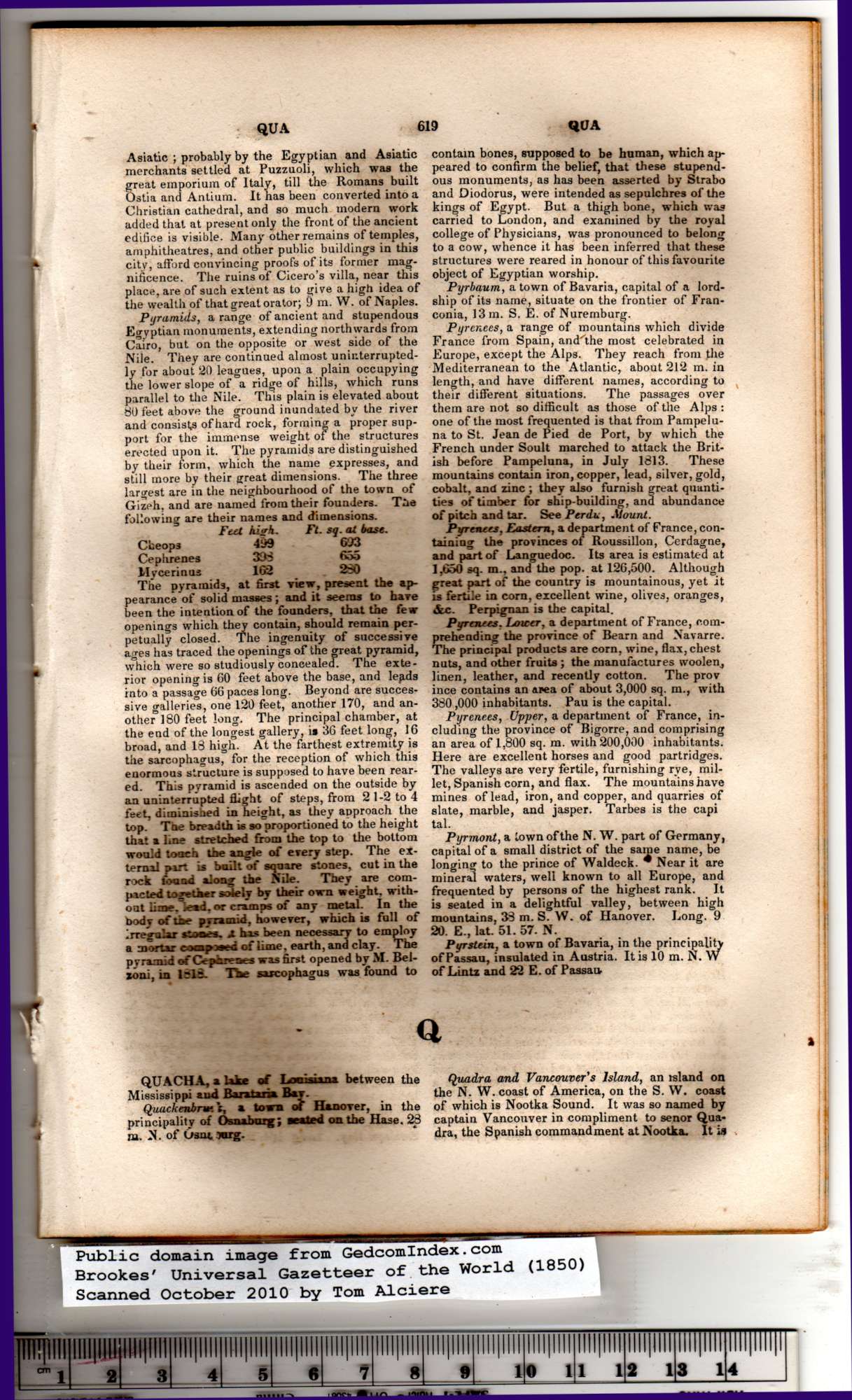|
Asiatic ; probably by the Egyptian and Asiatic
merchants settled at Puzzuoli, which was the
great emporium of Italy, till the Romans built
Ostia and Antium. It has been converted into a
Christian cathedral, and so much modern work
added that at present only the front of the ancient
edifice is visible. Many other remains of temples,
amphitheatres, and other public buildings in this
city, afford convincing proofs of its former mag-
nificence. The ruins of Cicero’s villa, near this
place, are of such extent as to give a high idea of
the wealth of that great orator; 9 m. W. of Naples.
Pyramids, a range of ancient and stupendous
Egyptian monuments, extending northwards from
Cairo, but on the opposite or west side of the
Nile. They are continued almost uninterrupted-
ly for about 20 leagues, upon a plain occupying
the lower slope of a ridge of hills, which runs
parallel to the Nile. This plain is elevated about
80 feet above the ground inundated by the river
and consists ofhara rock, forming a proper sup-
port for the immense weight of the structures
erected upon it. The pyramids are distinguished
by their form, which the name expresses, and
still more by their great dimensions. The three
largest are in the neighbourhood of the town of
Gizeh, and are named from their founders. The
following are their names and dimensions.
FtU high. Ft. sq. at base.
Cheops 499 633
Cephrenes 398 655
II ycerinus 162 250
The pyramids, at firet view, present the ap-
pearance of solid masses ; and it seems to have
been the intention of the founders, that the few
openings which they contain, should remain per-
petually closed. The ingenuity of successive
ages has traced the openings of the great pyramid,
which were so studiously concealed. The exte-
rior opening is 60 feet above the base, and lepds
into a passage 66 paces long. Beyond are succes-
sive galleries, one 120 feet, another 170, and an-
other 180 feet long. The principal chamber, at
the end of the longest gallery, is 36 feet long, 16
broad, and 18 high. At the farthest extremity is
the sarcophagus, for the reception of which this
enormous structure is supposed to have been rear-
ed. This pyramid is ascended on the outside by
an uninterrupted flight of steps, from 2 1-2 to 4
feet, diminished in height, as they approach the
top. Tne breadth is so proportioned to the height
that a line stretched from the top to the bottom
would touch tae angle of every step. The ex-
ternal part is built of square stones, cut in the
rock found along the Nile. They are com-
pacted together solely by their own weight, with-
out lime. lead, or cramps of any metal. In the
bodv of the pyramid, however, which is full of
irregular stones, x has been necessary to employ
a mortar caapased of lime, earth, and clay. The
p vramid of Cephreses was first opened by M. Bel-
zoni, in 161s. Tae sarcophagus was found to
contain bones, supposed to be human, which ap-
peared to confirm the belief, that these stupend-
ous monuments, as has been asserted by Strabo
and Diodorus, were intended as sepulchres of the
kings of Egypt. But a thigh bone, which was
carried to London, and examined by the royal
college of Physicians, was pronounced to belong
to a cow, whence it has been inferred that these
structures were reared in honour of this favourite
object of Egyptian worship. |
Pyrbaum, a town of Bavaria, capital of a lord-
ship of its name, situate on the frontier of Fran-
conia, 13 m. S. E. of Nuremburg.
Pyrenees, a range of mountains which divide
France from Spain, and'the most celebrated in
Europe, except the Alps. They reach from the
Mediterranean to the Atlantic, about 212 m. in
length, and have different names, according to
their different situations. The passages over
them are not so difficult as those ofthe Alps:
one of the most frequented is that from Pampelu-
na to St. Jean de Pied de Port, by which the
French under Soult marched to attack the Brit-
ish before Pampeluna, in July 1813. These
mountains contain iron, copper, lead, silver, gold,
cohalt, and zinc ; they also furnish great quanti-
ties of timber for ship-building, and abundance
of pitch and tar. See Perdu, Mount.
Pyrenees, Eastern, a department of France, con-
taining the provinces of Roussillon, Cerdagne,
and part of Languedoc. Its area is estimated at
1,650 sq. m., and the pop. at 126,500. Although
great part of the country is mountainous, yet it
is fertile in corn, excellent wine, olives, oranges,
&c. Perpignan is the capital.
Pyrenees, Lower, a department of France, com-
prehending the province of Bearn and Navarre.
The principal products are corn, wine, flax, chest
nuts, and other fruits ; the manufactures woolen,
linen, leather, and recently cotton. The prov
ince contains an area of about 3,000 sq. m., with
380,000 inhabitants. Pau is the capital.
Pyrenees, Upper, a department of France, in-
cluding the province of Bigorre, and comprising
an area of 1,800 sq. m. with 200,000 inhabitants.
Here are excellent horses and good partridges.
The valleys are very fertile, furnishing rye, mil-
let, Spanish corn, and flax. The mountains have
mines of lead, iron, and copper, and quarries of
slate, marble, and jasper. Tarbes is the capi
tal.
Pijrmont, a town ofthe N. W. part of Germany,
capital of a small district of the same name, be
longing to the prince of Waldeck. * Near it are
mineral waters, well known to all Europe, and
frequented by persons of the highest rank. It
is seated in a delightful valley, between high
mountains, 38 m. S. W. of Hanover. Long. 9
20. E., lat. 51. 57. N.
Pyrstein, a town of Bavaria, in the principality
of Passau, insulated in Austria. It is 10 m. N. W
of Lintz and 22 E. of Passau |
